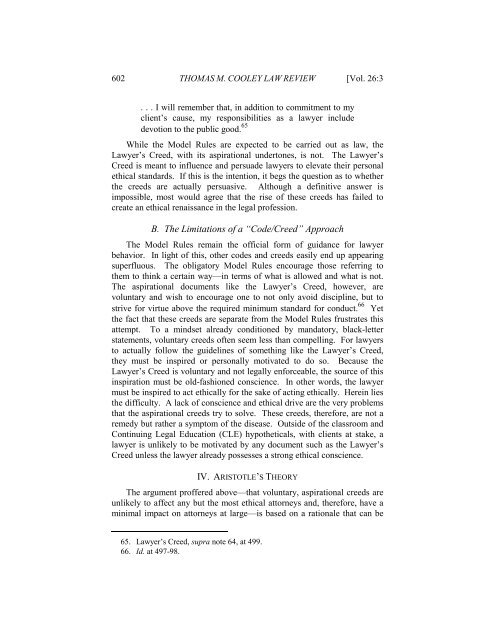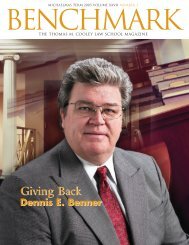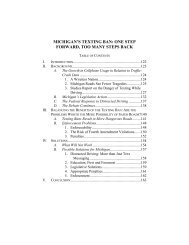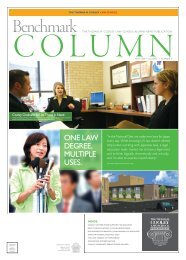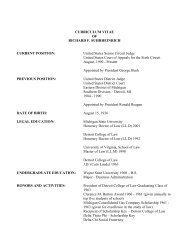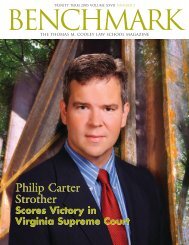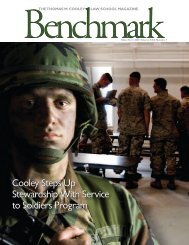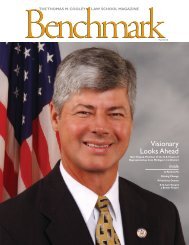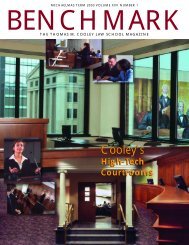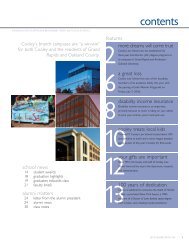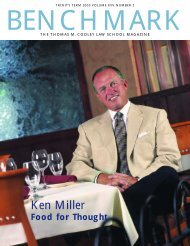Beyond The Model Rules - Thomas M. Cooley Law School
Beyond The Model Rules - Thomas M. Cooley Law School
Beyond The Model Rules - Thomas M. Cooley Law School
You also want an ePaper? Increase the reach of your titles
YUMPU automatically turns print PDFs into web optimized ePapers that Google loves.
602 THOMAS M. COOLEY LAW REVIEW [Vol. 26:3. . . I will remember that, in addition to commitment to myclient’s cause, my responsibilities as a lawyer includedevotion to the public good. 65While the <strong>Model</strong> <strong>Rules</strong> are expected to be carried out as law, the<strong>Law</strong>yer’s Creed, with its aspirational undertones, is not. <strong>The</strong> <strong>Law</strong>yer’sCreed is meant to influence and persuade lawyers to elevate their personalethical standards. If this is the intention, it begs the question as to whetherthe creeds are actually persuasive. Although a definitive answer isimpossible, most would agree that the rise of these creeds has failed tocreate an ethical renaissance in the legal profession.B. <strong>The</strong> Limitations of a “Code/Creed” Approach<strong>The</strong> <strong>Model</strong> <strong>Rules</strong> remain the official form of guidance for lawyerbehavior. In light of this, other codes and creeds easily end up appearingsuperfluous. <strong>The</strong> obligatory <strong>Model</strong> <strong>Rules</strong> encourage those referring tothem to think a certain way—in terms of what is allowed and what is not.<strong>The</strong> aspirational documents like the <strong>Law</strong>yer’s Creed, however, arevoluntary and wish to encourage one to not only avoid discipline, but tostrive for virtue above the required minimum standard for conduct. 66 Yetthe fact that these creeds are separate from the <strong>Model</strong> <strong>Rules</strong> frustrates thisattempt. To a mindset already conditioned by mandatory, black-letterstatements, voluntary creeds often seem less than compelling. For lawyersto actually follow the guidelines of something like the <strong>Law</strong>yer’s Creed,they must be inspired or personally motivated to do so. Because the<strong>Law</strong>yer’s Creed is voluntary and not legally enforceable, the source of thisinspiration must be old-fashioned conscience. In other words, the lawyermust be inspired to act ethically for the sake of acting ethically. Herein liesthe difficulty. A lack of conscience and ethical drive are the very problemsthat the aspirational creeds try to solve. <strong>The</strong>se creeds, therefore, are not aremedy but rather a symptom of the disease. Outside of the classroom andContinuing Legal Education (CLE) hypotheticals, with clients at stake, alawyer is unlikely to be motivated by any document such as the <strong>Law</strong>yer’sCreed unless the lawyer already possesses a strong ethical conscience.IV. ARISTOTLE’S THEORY<strong>The</strong> argument proffered above—that voluntary, aspirational creeds areunlikely to affect any but the most ethical attorneys and, therefore, have aminimal impact on attorneys at large—is based on a rationale that can be65. <strong>Law</strong>yer’s Creed, supra note 64, at 499.66. Id. at 497-98.


